Skycore Aviation is pleased to introduce a new series on the General Electric T700 engine powering the Black Hawk. Through our series of articles, we will look at the development of the turbine engine, discuss its key modules, identify key steps to refurbishing the T700-GE-700 and address replacing the 700 with a 701C/D in a Black Hawk.
T700-GE-700 Development
In the late 1960’s the U.S. Army initiated the replacement of the UH-1 Iroquois as well as a new common turbine engine with greater performance, survivability and reliability requirements. As a result of the Army’s requirement, the General Electric T700 was developed to operate in hot and high altitudes, with improved performance, and a reduced maintenance footprint.
Over the last 4 decades, over 20,000 T700 engines have been manufactured, flying over 100 million hours for 50 countries. The engine has been used in scores of aircraft from AugustaWestland AW101, AW149 and AW189, Bell attack helicopters, Boeing AH-64 Apache and the family of Sikorsky Black Hawk helicopters. The civil version of the T700-GE-700, the CT7, is also used in turboprop aircraft such as the CASA CN-235, LET L-610G, Saab 340 and the Sukhoi SU-80.
T700 Engine Modules
The T700 was created using a modular design to ease maintenance including the size of the maintenance footprint during missions. This design allows the engine to be disassembled into the four modules – Cold Section Module, Hot Section Module, Power Turbine Module and Accessory Section Module.
T700 engines are mounted to the Black Hawk airframe on both sides of the main transmission. The mechanical link between the engines, the main rotor system, and cockpit indications is the power turbine connection to the main rotor system through drive shafts and gearboxes. This mechanical connection is a one-way connection. The power turbine drives the main rotor system, but when the main rotor speed exceeds power turbine speed (as in autorotation), the power turbine will decouple from the drivetrain via a freewheeling unit.
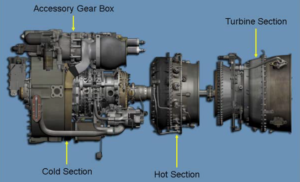
The four modules of a T700 engine
T700 Engine Cold Section Module
The overall purpose of the cold section module is to provide clean and unrestricted airflow to the T700 engine. It’s made up to two sections – the inlet and compressor. The inlet section takes in the air, separates then discharges particles/debris and sends the cleansed air into the compressor. The compressor consists of a 6-stage air pump that continuously pressurizes the air in the chamber. After the pressurized air leaves the compressor, the remaining subsections of the cold section module bleeds the pressurized air, cools the hot section components and supplies air for combustion.
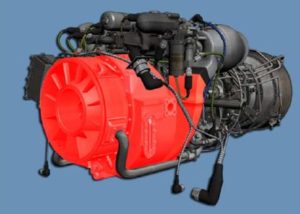
The Cold Section Module of a T700 engine
T700 Engine Hot Section
The T700 hot section module consists of the combustion chamber, turbine and exhaust. The combustion chamber ignites and controls the burning fuel and air. It releases heat so the air expands and accelerates to provide a smooth and stable stream of uniformly-heated gas. This process is accomplished by ignitors along with rotors and turbine stators.
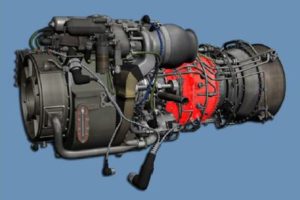
The Hot Section Module of a T700 engine
T700 Engine Power Turbine Module
The power turbine module converts gas pressure into energy to power the drive train. The power turbine is comprised of a 2-stage power turbine rotor, casing and exhaust frame. The drive shaft assembly links the power turbine to the rotor system with oversight from a torque indicating system that shows the amount of power the engine is delivering to the main transmission.
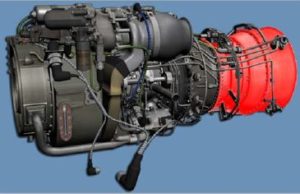
The Power Turbine Module of a T700 engine
T700 Engine Accessory Section Module
The accessory section module, also known as the accessory gearbox (AGB), powers the engine accessories. It’s mounted across the top of the cold section and bolted to the top of the main frame. Some accessories are sensors such as oil temperature and pressure. Other accessories perform functions such as the fuel and oil pumps, alternator and bypass switch to name a few.
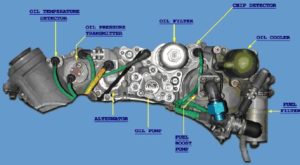
The various accessories within the Accessory Section Module of the T700 engine
Skycore Aviation
Skycore Aviation is an international helicopter personnel services and UH-60 Black Hawk provider. Our knowledge and experience enable Skycore to provide personnel and turnkey solutions for helicopter programs tailored to meet customer operations, maintenance and training needs. Follow us on LinkedIn, Twitter and Facebook to stay atop of the rotary wing industry.

